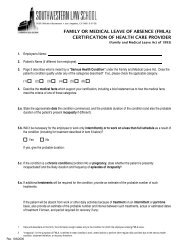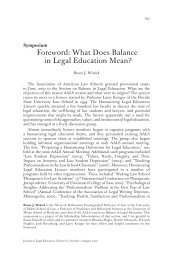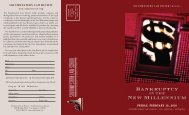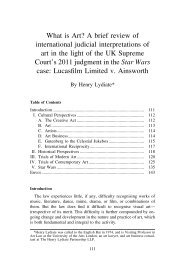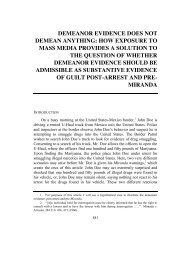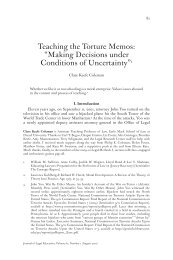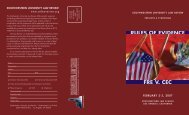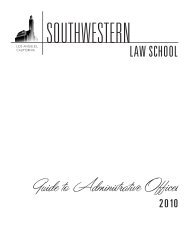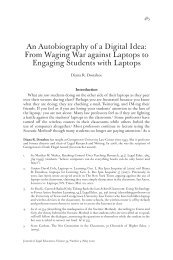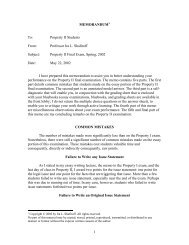if âi do,â then so should you - Southwestern Law School
if âi do,â then so should you - Southwestern Law School
if âi do,â then so should you - Southwestern Law School
Create successful ePaper yourself
Turn your PDF publications into a flip-book with our unique Google optimized e-Paper software.
COHEN MACRO (DO NOT DELETE)5/10/2010 4:56 PM2009] IF “I DO,” THEN SO SHOULD YOU 369to permitting such marriage. 38 Although not a case involving a stateconstitution ban on marriage for same-sex couples, 39 Goodridge,nonetheless, used constitutional law to redefine the Commonwealth‟sadministrative scheme that regulated marriage and denied marriage forsame-sex couples. 40 Spec<strong>if</strong>ically, the court in Goodridge first addressed theright to marriage itself and concluded that “[t]he liberty interest in choosingwhether and whom to marry would be hollow <strong>if</strong> the Commonwealth [ofMassachusetts] could, without sufficient just<strong>if</strong>ication, foreclose anindividual from freely choosing the per<strong>so</strong>n with whom to share an exclusivecommitment in the unique institution of civil marriage.” 41 The court <strong>then</strong>addressed the plaint<strong>if</strong>fs‟ due process and equal protection arguments 42 andheld that, even under a rational basis level of scrutiny, 43 “[l]imiting theprotections, benefits, and obligations of civil marriage to opposite-sexcouples violates the basic premises of individual liberty and equality underlaw protected by the Massachusetts Constitution.” 44 Accordingly, the court“construe[d] civil marriage to mean the voluntary union of two per<strong>so</strong>ns asspouses, to the exclusion of all others.” 45 Thus, the court‟s “reformulation[of marriage] redresse[d] the . . . constitutional injury and further[ed] theaim of marriage to promote stable, exclusive relationships. It advances thetwo legitimate State interests . . . ident<strong>if</strong>ied: providing a stable setting forchild rearing and conserving State re<strong>so</strong>urces. It leaves intact theLegislature‟s broad discretion to regulate marriage.” 46Although Goodridge was ground-breaking in its ruling, it would takeanother five years before any other state high court would legitimizemarriage for same-sex couples. 47 The case allowing marriage for same-sexcouples in Cal<strong>if</strong>ornia, In re Marriage Cases, 48 will be reviewed below incontext with the voter initiative overturning it. 49 However, shortly afterIn re Marriage Cases, the Connecticut Supreme Court announced that38. Id. at 969-70; Kathleen Burge, SJC: Gay Marriage Legal in Mass., BOSTON GLOBE,Nov. 18, 2003, http://www.boston.com/news/local/massachusetts/articles/2003/11/18/sjc_gay_marriage_legal_in_mass/.39. Goodridge, 798 N.E.2d at 948.40. Id.41. Id. at 959.42. Id. at 960-68.43. Id. at 961.44. Id. at 968.45. Goodridge, 798 N.E.2d at 969.46. Id.47. See In re Marriage Cases, 183 P.3d 384 (Cal. 2008).48. Id.49. See supra notes 3-4 and accompanying text.
COHEN MACRO (DO NOT DELETE)5/10/2010 4:56 PM2009] IF “I DO,” THEN SO SHOULD YOU 371In applying the intermediate scrutiny standard, the court examined thestate‟s proffered “rea<strong>so</strong>ns why the legislature has prohibited same sexmarriage: (1) to promote un<strong>if</strong>ormity and consistency with the laws of otherjurisdictions; and (2) to preserve the traditional definition of marriage as aunion between one man and one woman.” 58 As a result of examining thedefendant‟s arguments under the intermediate scrutiny standard, 59 the courtfound that “the state . . . failed to establish adequate rea<strong>so</strong>n to just<strong>if</strong>y thestatutory ban on same sex marriage.” 60 The court al<strong>so</strong> found that the“statutory scheme governing marriage cannot stand in<strong>so</strong>far as it bars samesex couples from marrying.” 61 As a result, the court ultimately held that“same sex couples cannot be denied the free<strong>do</strong>m to marry.” 62 Therefore,while Massachusetts and Connecticut now permit their same-sex couples tomarry, there exists a majority of states that constitutionally ban marriage forsame-sex couples. 63B. States That Constitutionally Ban Marriage for Same-Sex CouplesCal<strong>if</strong>ornia came close to being included amongst the states that permitmarriage for same-sex couples. 64 Cal<strong>if</strong>ornia initially allowed marriage forsame-sex couples through its Supreme Court‟s decision in In re MarriageCases. 65 In that opinion, the Cal<strong>if</strong>ornia Supreme Court found that the statestatutes banning marriage for same-sex couples were “unconstitutional[under the state constitution] to the extent each statute reserves thedesignation of marriage exclusively to opposite-sex couples and deniessame-sex couples access to that designation.” 66 Particularly, the “retentionof the traditional definition of marriage <strong>do</strong>es not constitute a state interestsufficiently compelling, under the strict scrutiny equal protection standard,to just<strong>if</strong>y withholding that status from same-sex couples.” 67 Beforeand <strong>do</strong>es not inhibit state governments from affording higher levels of protection for suchrights.”Id. (citation omitted); see al<strong>so</strong> Kerrigan, 957 A.2d at 423.58. Kerrigan, 957 A.2d at 476-81.59. Id. at 423.60. Id. at 481.61. Id.62. Id. at 482.63. See L.A. Times, Interactive: Gay Marriage Chronology, http://www.latimes.com/news/local/la-gmtimeline-fl,0,5345296.htmlstory (last visited Oct. 30, 2009).64. See supra notes 2-5.65. 183 P.3d 384, 453 (Cal. 2008).66. Id. at 452.67. Id.
05 COHEN (FINAL) (DO NOT DELETE) 5/10/2010 4:56 PM372 SOUTHWESTERN LAW REVIEW [Vol. 39Connecticut used its intermediate scrutiny standard, 68 Cal<strong>if</strong>ornia used astrict scrutiny equal protection standardbecause (1) the statutes in question properly must be understood asclass<strong>if</strong>ying or discriminating on the basis of sexual orientation, acharacteristic that we conclude represents—like gender, race, andreligion—a constitutionally suspect basis upon which to imposed<strong>if</strong>ferential treatment, and (2) the d<strong>if</strong>ferential treatment at issue impingesupon a same-sex couple‟s fundamental interest in having their familyrelationship accorded the same respect and dignity enjoyed by anopposite-sex couple. 69Thus, “[h]aving concluded that [the two statutes were] unconstitutionalto the extent each statute reserves the designation of marriage exclusively toopposite-sex couples and denies same-sex couples access to thatdesignation,” 70 the Cal<strong>if</strong>ornia Supreme Court determined the proper remedyto be a repeal of one statute and a re-wording of the other statute, “mak[ing]the designation of marriage available both to opposite-sex and same-sexcouples.” 71However, the voters of Cal<strong>if</strong>ornia reacted to the state high court‟sdecision by narrowly passing a ballot proposition, commonly known asProposition 8. 72 The passage of Proposition 8 changed Cal<strong>if</strong>ornia‟sconstitution in order to eliminate the right of marriage for same-sexcouples. 73 Spec<strong>if</strong>ically, Cal<strong>if</strong>ornia‟s constitution now states that “[o]nlymarriage between a man and a woman is valid or recognized inCal<strong>if</strong>ornia.” 74 However, while Proposition 8 is a clear ban on marriage forsame-sex couples moving forward, the passage of Proposition 8 created aquagmire whereby “the fate of the estimated 18,000 same-sex marriages”officiated after the decision of In re Marriage Cases, but before the passageof Proposition 8, is ambiguous at best. 75 For this rea<strong>so</strong>n, and for othersrelating to state constitutional law, Cal<strong>if</strong>ornia‟s high court reviewedProposition 8 for possible repeal. 7668. See Kerrigan v. Comm‟r of Pub. Health, 957 A.2d 407, 423 (Conn. 2008).69. In re Marriage Cases, 183 P.3d at 401.70. Id. at 452.71. Id. at 453.72. See supra note 3.73. See supra notes 3-4.74. See supra note 4.75. See Jessica Garri<strong>so</strong>n & Maura Dolan, Brown Asks Justices to Toss Prop. 8, L.A. TIMES,Dec. 20, 2008, at A23 (“[Opponents argue] that Proposition 8 was not written to be retroactive andthat the marriages <strong>should</strong> remain valid. [Supporters of Proposition 8] argue[] that no same-sexmarriages <strong>should</strong> any longer be recognized.”).76. Id. at A1.
COHEN MACRO (DO NOT DELETE)5/10/2010 4:56 PM2009] IF “I DO,” THEN SO SHOULD YOU 373Although the Cal<strong>if</strong>ornia Supreme Court upheld Proposition 8, it al<strong>so</strong>validated the approximately 18,000 same-sex marriages officiated prior toProposition 8‟s passage. 77 As such, Cal<strong>if</strong>ornia joined the majority of statesthat use constitutional means to ban marriage for same-sex couples. 78 Forexample, Alaska, Colora<strong>do</strong>, Georgia, Oregon and Texas already had stateconstitutional bans on marriage for same-sex couples in place by the timeArizona, Cal<strong>if</strong>ornia, and Florida passed their measures. 79 These five stateshighlight state constitutional amendments that (1) ban same-sex marriageand civil union like equivalents, (2) ban same-sex marriage, or (3) bansame-sex marriage, but allow civil union-like equivalents. 80Georgia and Texas are among the approximately nineteen states thatconstitutionally ban marriage and its equivalents for same sex couples. 81Enacted by a voter initiative in 2004, Georgia‟s constitution was amendedto read:(a) This state shall recognize as marriage only the union of man andwoman. Marriages between per<strong>so</strong>ns of the same sex are prohibited in thisstate.(b) No union between per<strong>so</strong>ns of the same sex shall be recognized by thisstate as entitled to the benefits of marriage. This state shall not give effectto any public act, record, or judicial proceeding of any other state orjurisdiction respecting a relationship between per<strong>so</strong>ns of the same sex thatis treated as a marriage under the laws of such other state or jurisdiction.The courts of this state shall have no jurisdiction to grant a divorce orseparate maintenance with respect to any such relationship or otherwise toconsider or rule on any of the parties‟ respective rights arising as a resultof or in connection with such relationship. 82Similarly, in 2005, Texas voters a<strong>do</strong>pted a measure amending thestate‟s constitution to read: “(a) Marriage in this state shall consist only ofthe union of one man and one woman. (b) This state or a politicalsubdivision of this state may not create or recognize any legal statusidentical or similar to marriage.” 83 Approximately seventeen other statesdeprive same sex couples of not only the right to marry, but al<strong>so</strong> any otherequivalent form allowing similar rights and benefits. 84 As a result, this77. Strauss v. Horton, 207 P.3d 48, 122 (Cal. 2009).78. See supra note 11.79. See supra notes 3-4, 8-11, 35.80. See supra notes 11, 35.81. See GA. CONST. art. I, § 4, 1 (amended 2004); TEX. CONST. art. I, § 32 (amended2005).82. GA. CONST. art. I, § 4, 1 (amended 2004).83. TEX. CONST. art. I, § 32 (amended 2005).84. See supra note 11.
05 COHEN (FINAL) (DO NOT DELETE) 5/10/2010 4:56 PM374 SOUTHWESTERN LAW REVIEW [Vol. 39strictest form of a state constitutional ban leaves same-sex couples withlittle to no legal recourse in securing any marriage-like benefits through acivil union, <strong>do</strong>mestic partnership, or otherwise.While not as prohibitive as Georgia or Texas, Alaska and Colora<strong>do</strong> areamong the approximately ten states that constitutionally ban <strong>so</strong>lely marriagefor same sex couples. 85 Colora<strong>do</strong>‟s state constitution declares that “[o]nly aunion of one man and one woman shall be valid or recognized as a marriagein this state.” 86 Alaska‟s state constitution states that “[t]o be valid orrecognized in this State, a marriage may exist only between one man an<strong>do</strong>ne woman.” 87 Additionally, Alaska is one state that al<strong>so</strong> statutorily bansmarriage equivalents. 88 Such a combination of measures al<strong>so</strong> severelylimits the options of marriage-like rights available to same-sex couples.However, <strong>so</strong>me states, like Oregon, constitutionally ban marriage forsame-sex couples, but permit a civil union or <strong>do</strong>mestic partnershipequivalent. 89 Oregon‟s state constitution reads: “It is the policy of Oregon,and its political subdivisions, that only a marriage between one man an<strong>do</strong>ne woman shall be valid or legally recognized as a marriage.” 90 In directresponse, the Oregon legislature passed the Oregon Family Fairness Act,which established the right of same-sex couples to enter into a <strong>do</strong>mesticpartnership. 91 Thus, while Oregon may have constitutionally bannedmarriage itself, it has made an alternative available to its same-sexcouples. 92 Nevertheless, state constitutional bans on same-sex marriage notonly involve the right to marry, but al<strong>so</strong> the right to the political process.III. THE RIGHT TO THE POLITICAL PROCESSConstitutional amendments increase the d<strong>if</strong>ficulties for a per<strong>so</strong>n orgroup of people to assert their political rights and participate in the politicalprocess. This section shall briefly discuss the historic U.S. Supreme Courtcases that established the right to participate in the political process under85. See ALASKA CONST. art. I, § 25 (amended 1999); COLO. CONST. art. II, § 31 (amended2006).86. COLO. CONST. art. II, § 31 (amended 2006).87. ALASKA CONST. art. I, § 25 (amended 1999).88. ALASKA STAT. § 25.05.013(b) (2008) (“A same-sex relationship may not be recognizedby the state as being entitled to the benefits of marriage.”).89. OR. CONST. art. XV, § 5a (amended 2004); see OR. REV. STAT. §§ 106.310, 106.325(2009).90. OR. CONST. art. XV, § 5a (amended 2004).91. See OR. REV. STAT. §§ 106.300-.325.92. See OR. CONST. art. XV, § 5a (amended 2004); OR. REV. STAT. §§ 106.310, 106.325.
COHEN MACRO (DO NOT DELETE)5/10/2010 4:56 PM2009] IF “I DO,” THEN SO SHOULD YOU 375the U.S. Constitution. 93 The right to participate in the political processmeans there can be no interference with the interest of such a fundamentalcreature. 94 Furthermore, one cannot discriminate against a class of peoplewhen there is an underlying natural right. 95 To conclude this section, thisComment will argue that more recent support for these concepts comesfrom a U.S. Supreme Court case regarding equal protection forhomosexuals, Romer v. Evans, 96 a U.S. Supreme Court case historically tiedto an equal protection standard of review for homosexuals.A. Harper v. Virginia Board of ElectionsPrior to the ruling in Harper v. Virginia Board of Elections, 97 theVirginia constitution required a poll tax on all voters over the age oftwenty-one. 98 In response, Virginia residents brought suit for a declarationof such poll tax being unconstitutional. 99 In its examination of the suit, theCourt utilized the Fourteenth Amendment 100 because “the Equal ProtectionClause of the Fourteenth Amendment restrains the States from fixing voterqual<strong>if</strong>ications which invidiously discriminate.” 101 The Court first declaredthatthe right of suffrage is a fundamental matter in a free and democratic<strong>so</strong>ciety. Especially since the right to exercise the franchise in a free andunimpaired manner is preservative of other basic civil and political rights,any alleged infringement of the right of citizens to vote must be carefullyand meticulously scrutinized. 102Furthermore, the Court held that “[w]ealth, like race, creed, or color, isnot germane to one‟s ability to participate intelligently in the electoralprocess. Lines drawn on the basis of wealth or property, like those of race,are traditionally disfavored.” 103 Moreover, the Court acknowledged that93. See Kramer v. Union Free Sch. Dist. No. 15, 395 U.S. 621 (1969); Harper v. Va. StateBd. of Elections, 383 U.S. 663 (1966).94. See Harper, 383 U.S. at 670.95. See id.96. 517 U.S. 620 (1996).97. 383 U.S. 663.98. Id. at 664 n.1.99. Id. at 664.100. Id. at 665 (“For it is enough to say that once the franchise [of voting] is granted to theelectorate, lines may not be drawn which are inconsistent with the Equal Protection Clause of theFourteenth Amendment.”).101. Id. at 666.102. Id. at 667 (quoting Reynolds v. Sims, 377 U.S. 533, 561-62 (1964)).103. Harper, 383 U.S. at 668.
05 COHEN (FINAL) (DO NOT DELETE) 5/10/2010 4:56 PM376 SOUTHWESTERN LAW REVIEW [Vol. 39“[they] have long been mindful that where fundamental rights and libertiesare asserted under the Equal Protection Clause, class<strong>if</strong>ications which mightinvade or restrain them must be closely scrutinized and carefullyconfined.” 104 Accordingly, the Court ruled that “wealth or fee paying has. . . no relation to voting qual<strong>if</strong>ications; the right to vote is too precious, toofundamental to be <strong>so</strong> burdened or conditioned.” 105B. Kramer v. Union Free <strong>School</strong> District No. 15The Court invoked similar sentiments as the Harper Court in Kramer v.Union Free <strong>School</strong> District No. 15. 106 In Kramer, a bachelor “who neitherown[ed] nor lease[d] taxable real property” challenged a New York statestatuteprovid[ing] that in certain . . . school districts residents who are otherwiseeligible to vote in . . . elections may vote in the school district electiononly <strong>if</strong> they (1) own (or lease) taxable real property within the district, or(2) are parents (or have custody of) children enrolled in the local publicschools. 107The plaint<strong>if</strong>f argued the statute was unconstitutional under the EqualProtection Clause of the Fourteenth Amendment, and the Court agreed. 108The Court in Kramer once again held that “any alleged infringement ofthe right of citizens to vote must be carefully and meticulouslyscrutinized.” 109 Furthermore, the Kramer Court found that “[a]nyunjust<strong>if</strong>ied discrimination in determining who may participate in politicalaffairs or in the selection of public officials undermines the legitimacy ofrepresentative government.” 110 Moreover, the Court held that “[s]tatutesgranting the franchise to residents on a selective basis always pose thedanger of denying <strong>so</strong>me citizens any effective voice in the governmentalaffairs which substantially affect their lives.” 111 Additionally, the Courtstated thatwhen we are reviewing statutes which deny <strong>so</strong>me residents the right tovote, the general presumption of constitutionality afforded state statutes104. Id. at 670.105. Id.106. 395 U.S. 621 (1969).107. Id. at 622.108. Id.109. Id. at 626 (quoting Reynolds v. Sims, 377 U.S. 533, 562 (1964)).110. Id.111. Id. at 626-27.
COHEN MACRO (DO NOT DELETE)5/10/2010 4:56 PM2009] IF “I DO,” THEN SO SHOULD YOU 377and the traditional approval given state class<strong>if</strong>ications <strong>if</strong> the Court canconceive of a “rational basis” for the distinctions made are not applicable.The presumption of constitutionality and the approval given “rational”class<strong>if</strong>ications in other types of enactments are based on an assumptionthat the institutions of state government are structured <strong>so</strong> as to representfairly all the people. However, when the challenge to the statute is ineffect a challenge of this basic assumption, the assumption can no longerserve as the basis for presuming constitutionality. And, the assumption isno less under attack because the legislature which decides who mayparticipate at the various levels of political choice is fairly elected.Legislation which delegates decision making to bodies elected by only aportion of those eligible to vote for the legislature can cause unfairrepresentation. Such legislation can exclude a minority of voters from anyvoice in the decisions just as effectively as <strong>if</strong> the decisions were made bylegislators the minority had no voice in selecting. 112The Court <strong>then</strong> ruled that the New York Statute “[did] not meet theexacting standard of precision [the Court] require[d] of statutes whichselectively distribute the franchise.” 113 Therefore, the Court held that “[t]herequirements of [the New York statute were] not sufficiently tailored tolimiting the franchise to those „primarily interested‟ in school affairs tojust<strong>if</strong>y the denial of the franchise to appellant and members of his class.” 114C. Romer v. EvansThirty years later, in Romer v. Evans, 115 the U.S. Supreme Courtreaddressed electoral rights. 116 In a case most notably as<strong>so</strong>ciated with theequal protection standard of review for homosexuals, 117 Romer al<strong>so</strong>reviewed rights as<strong>so</strong>ciated with the political process of constitutionalamendments in-context with the Equal Protection Clause. 118 AlthoughColora<strong>do</strong> now constitutionally bans marriage for same sex couples, 119Colora<strong>do</strong> once had a constitutional amendment that expressly “prohibit[ed]all legislative, executive or judicial action at any level of state or localgovernment designed to protect the named class, a class . . . refer[ed] to as112. Kramer, 395 U.S. at 627-28 (citation and footnotes omitted).113. Id. at 632.114. Id. at 633.115. Romer v. Evans, 517 U.S. 620 (1996).116. Id. at 623.117. See id. at 632-36.118. Id.119. See COLO. CONST. art. II, § 31 (amended 2006).
05 COHEN (FINAL) (DO NOT DELETE) 5/10/2010 4:56 PM378 SOUTHWESTERN LAW REVIEW [Vol. 39homosexual per<strong>so</strong>ns or gays and lesbians.” 120 A plethora of plaint<strong>if</strong>fsimmediately challenged the constitutional amendment out of fear of“immediate and substantial risk of discrimination on the basis of theirsexual orientation.” 121The discussion below will address the Court‟s determination ofscrutiny afforded to homosexuals under the Equal Protection Clause of theFourteenth Amendment. 122 For now, it is important to note the Court‟scomments towards the right to participate in the political process. TheCourt‟s comments came partly because of the Colora<strong>do</strong> State SupremeCourt‟s “reliance” on the U.S. Supreme Court‟s “voting rights cases” 123 inthe lower proceedings to hold that Colora<strong>do</strong>‟s constitutional amendment“was subject to strict scrutiny under the Fourteenth Amendment because itinfringed the fundamental right of gays and lesbians to participate in thepolitical process.” 124 Although the U.S. Supreme Court a<strong>do</strong>pted “arationale d<strong>if</strong>ferent from that a<strong>do</strong>pted by the [Colora<strong>do</strong>] State SupremeCourt,” 125 the U.S. Supreme Court did have a few choice words. 126After discussing the construction and interpretation of Colora<strong>do</strong>‟sconstitutional amendment, 127 the Court held:[T]he [Colora<strong>do</strong>] amendment imposes a special disability upon[homosexuals] alone. Homosexuals are forbidden the safeguards thatothers enjoy or may seek without constraint. [Homosexuals] can obtainspec<strong>if</strong>ic protection against discrimination only by enlisting the citizenry ofColora<strong>do</strong> to amend the State Constitution or perhaps, on the State‟s view,by trying to pass helpful laws of general applicability. 128Furthermore, the Court observed that “[t]he resulting disqual<strong>if</strong>icationof a class of per<strong>so</strong>ns from the right to seek spec<strong>if</strong>ic protection from the lawis unprecedented in [the Court‟s] jurisprudence.” 129 Additionally, the Courtfelt government‟s impartiality “to all who seek its assistance” is “[c]entralboth to the idea of the rule of law and to our own Constitution‟s guaranteeof equal protection.” 130 Moreover, the Court held that “[a] law declaring120. Romer, 517 U.S. at 624 (quoting COLO. CONST. art. II, § 30b (1993)).121. Id. at 625.122. See discussion infra Part V.123. See Kramer v. Union Free Sch. Dist. No. 15, 395 U.S. 621 (1969); Harper v. Va. StateBd. of Elections, 383 U.S. 663 (1966)124. Romer, 517 U.S. at 625.125. Id. at 626.126. See id. at 631, 633.127. Id. at 626-31.128. Id. at 631.129. Id. at 633.130. Romer, 517 U.S. at 633.
COHEN MACRO (DO NOT DELETE)5/10/2010 4:56 PM2009] IF “I DO,” THEN SO SHOULD YOU 379that in general it shall be more d<strong>if</strong>ficult for one group of citizens than for allothers to seek aid from the government is itself a denial of equal protectionof the laws in the most literal sense.” 131 Therefore, one could argue that abright line rule <strong>should</strong> be formed to determine the constitutionality of astate constitutional amendment <strong>if</strong> the state constitutional amendment: “(1) isaimed at a particular independently ident<strong>if</strong>iable group or category, (2)involves more than a mere repeal of existing law, and (3) distortsgovernmental processes in such a way as to place special burdens on theability of minority groups to achieve beneficial legislation.” 132IV. THE RIGHT TO MARRIAGEBesides the right to participate in the political process, a stateconstitutional amendment banning marriage for same-sex couples al<strong>so</strong>clearly involves the right to marry. The U.S. Supreme Court has long heldthe right to marriage as a fundamental right under the Due Process Clauseof the Fourteenth Amendment of the U.S. Constitution. 133 Arguably,Loving v. Virginia 134 is the most historical case regarding the right tomarriage. In Loving, an interracial couple brought suit over Virginia‟s lawsprohibiting such couples from marrying or being married within the state. 135The Court acknowledged the State‟s power to regulate marriage, but al<strong>so</strong>held that the State‟s regulation of marriage was still confined by theboundaries of the Fourteenth Amendment. 136 Moreover, the Court applied astrict scrutiny standard in evaluating the State‟s marriage laws because ofthe racial class<strong>if</strong>ications included therein. 137 In striking <strong>do</strong>wn Virginia‟s“invidious” discriminatory laws, the Court unambiguously held that[t]he free<strong>do</strong>m to marry has long been recognized as one of the vitalper<strong>so</strong>nal rights essential to the orderly pursuit of happiness by free men.Marriage is one of the “basic civil rights of man,” fundamental to our veryexistence and survival. To deny this fundamental free<strong>do</strong>m on <strong>so</strong>unsupportable a basis as the racial class<strong>if</strong>ications embodied in these131. Id.132. Mark Strasser, Same-Sex Marriage Referenda and the Constitution: On Hunter, Romer,and Electoral Process Guarantees, 64 ALB. L. REV. 949, 960-61 (2001) (footnotes and internalquotation marks omitted).133. See U.S. CONST. amend. XIV; Zablocki v. Redhail, 434 U.S. 374, 386 (1978); Loving v.Virginia, 388 U.S. 1, 12 (1967).134. 388 U.S. 1.135. Id. at 2-5.136. Id. at 7-8.137. Id. at 8-12.
05 COHEN (FINAL) (DO NOT DELETE) 5/10/2010 4:56 PM380 SOUTHWESTERN LAW REVIEW [Vol. 39statutes, class<strong>if</strong>ications <strong>so</strong> directly subversive of the principle of equalityat the heart of the Fourteenth Amendment, is surely to deprive all theState‟s citizens of liberty without due process of law. The FourteenthAmendment requires that the free<strong>do</strong>m of choice to marry not be restrictedby invidious racial discriminations. Under our Constitution, the free<strong>do</strong>mto marry or not marry, a per<strong>so</strong>n of another race resides with the individualand cannot be infringed by the State. 138In Zablocki v. Redhail, 139 the Court used even more explicit languagein affirming the right to marriage. 140 While not involving racialclass<strong>if</strong>ications, the Wisconsin laws at issue in Zablocki class<strong>if</strong>ied a group ofpeople drawn along d<strong>if</strong>ferent lines—unmarried parents who owed childsupport. 141 As a result, the Court examined Wisconsin‟s laws under theFourteenth Amendment and used a strict scrutiny standard. 142 The Courtparticularly highlighted “the right to marry [as] of fundamental importancefor all individuals.” 143 Furthermore, “the Court [in Maynard v. Hill]characterized marriage as the most important relation in l<strong>if</strong>e.” 144 Moreover,the Court noted that “the right to marry is part of the fundamental right ofprivacy implicit in the Fourteenth Amendment‟s Due Process Clause, . . .[and] categorized the decision to marry as among the per<strong>so</strong>nal decisionsprotected by the right of privacy.” 145 The Court additionally held:By reaffirming the fundamental character of the right to marry, we <strong>do</strong> notmean to suggest that every state regulation which relates in any way to theincidents of or prerequisites for marriage must be subjected to rigorousscrutiny. To the contrary, rea<strong>so</strong>nable regulations that <strong>do</strong> not sign<strong>if</strong>icantlyinterfere with decisions to enter into the marital relationship maylegitimately be imposed. The statutory class<strong>if</strong>ication at issue here,however, clearly <strong>do</strong>es interfere directly and substantially with the right tomarry. 146Therefore, under a strict scrutiny standard, the Court struck <strong>do</strong>wnWisconsin‟s laws limiting the right to marriage. 147138. Id. at 12 (citations omitted).139. 434 U.S. 374 (1978).140. Id. at 386-87.141. Id. at 375.142. Id. at 383 (“Since our past decisions make clear that the right to marry is of fundamentalimportance, and since the class<strong>if</strong>ication at issue here sign<strong>if</strong>icantly interferes with the exercise ofthat right, we believe that „critical examination‟ of the state interests advanced in support of theclass<strong>if</strong>ication is required.”).143. Id. at 384.144. Id. (citation and internal quotation marks omitted).145. Zablocki, 434 U.S. at 384 (internal quotation marks omitted).146. Id. at 386-87 (citation omitted).147. Id. at 388-91.
COHEN MACRO (DO NOT DELETE)5/10/2010 4:56 PM2009] IF “I DO,” THEN SO SHOULD YOU 381Although a state constitutional ban on marriage for same-sex couplesinvolves the rights to marriage and participation in the political process,said bans al<strong>so</strong> discriminate against a single class<strong>if</strong>ication of people, i.e.,homosexuals. Consequently, state constitutional bans on marriage forsame-sex couples <strong>should</strong> al<strong>so</strong> be examined under an equal protectionanalysis. The discussion shall now turn to the level of scrutiny afforded tohomosexuals by the U.S. Supreme Court under the Equal Protection Clauseof the Fourteenth Amendment. 148V. EQUAL PROTECTION OF HOMOSEXUALSTwo cases are historically tied to the equal protection of homosexuals:Romer v. Evans 149 and <strong>Law</strong>rence v. Texas. 150 Although the right toparticipate in the political process was heavily burdened in Romer, 151 theCourt relied more on an equal protection analysis in rendering itsdecision. 152 In its equal protection analysis, the Court utilized the loweststandard, a rational basis standard for equal protection, without directlyexplaining or labeling homosexuals as a non-suspect class. 153 With thelower, rational basis standard being used, the Court still managed to unearththe flagrant and invidious discriminatory nature of Colora<strong>do</strong>‟sconstitutional amendment. 154 Above all, the Court provided:We cannot say that [the Colora<strong>do</strong> constitutional amendment] is directed toany ident<strong>if</strong>iable legitimate purpose or discrete objective. It is a statusbasedenactment divorced from any factual context from which we coulddiscern a relationship to legitimate state interests; it is a class<strong>if</strong>ication ofper<strong>so</strong>ns undertaken for its own sake, <strong>so</strong>mething the Equal ProtectionClause <strong>do</strong>es not permit. Class legislation is obnoxious to the prohibition<strong>so</strong>f the Fourteenth Amendment. We must conclude that Amendment 2class<strong>if</strong>ies homosexuals not to further a proper legislative end but to makethem unequal to everyone else. This Colora<strong>do</strong> cannot <strong>do</strong>. 155148. See U.S. CONST. amend. XIV; <strong>Law</strong>rence v. Texas, 539 U.S. 558 (2003); Romer v. Evans,517 U.S. 620 (1996).149. 517 U.S. 620.150. 539 U.S. 558.151. See supra discussion Part III.C.152. Romer, 517 U.S. at 631-32 (“[Under the Fourteenth Amendment,] <strong>if</strong> a law neitherburdens a fundamental right nor targets a suspect class, we will uphold the legislativeclass<strong>if</strong>ication <strong>so</strong> long as it bears a rational relation to <strong>so</strong>me legitimate end. Amendment 2 fails,indeed defies, even this conventional inquiry.” (citation omitted)).153. Id. at 631-33.154. Id. at 633-36.155. Id. at 635 (citation and internal quotation marks omitted).
05 COHEN (FINAL) (DO NOT DELETE) 5/10/2010 4:56 PM382 SOUTHWESTERN LAW REVIEW [Vol. 39Therefore, the Court held that the Colora<strong>do</strong> constitutional amendment wasunconstitutional under a rational basis standard of equal protection becauseit lacked any rational relationship to a legitimate legislative purpose. 156Equal protection standards for homosexuals were discussed once againwithin <strong>Law</strong>rence v. Texas. 157 At issue in <strong>Law</strong>rence were Texas statutes thatprohibited “certain intimate sexual conduct” between members of the samesex. 158 Even though the decision in <strong>Law</strong>rence turned on an analysis of theDue Process Clause of the Fourteenth Amendment, 159 the Courtacknowledged an equal protection argument as “tenable” pursuant to theholdings in Romer. 160 The Court felt that <strong>if</strong> it held[t]he statute invalid under the Equal Protection Clause <strong>so</strong>me mightquestion whether a prohibition would be valid <strong>if</strong> drawn d<strong>if</strong>ferently, say, toprohibit the conduct both between same-sex and d<strong>if</strong>ferent-sex participants.Equality of treatment and the due process right to demand respect forconduct protected by the substantive guarantee of liberty are linked inimportant respects, and a decision on the latter point advances bothinterests. If protected conduct is made criminal and the law which <strong>do</strong>es <strong>so</strong>remains unexamined for its substantive validity, its stigma might remaineven <strong>if</strong> it were not enforceable as drawn for equal protection rea<strong>so</strong>ns. 161Thus, the Court rendered its decision based on the Due Process Clause ofthe Fourteenth Amendment. 162However, the Court‟s ultimate decision did not end the equal protectiondiscussion. 163 Justice O‟Connor opined on the equal protection argument inher concurrence. 164 Justice O‟Connor first argued that a rational basisstandard of equal protection could have applied in <strong>Law</strong>rence and resulted inthe same decision to strike <strong>do</strong>wn the Texas laws, but Justice O‟Connorimplied a sharper version of rational basis could have al<strong>so</strong> applied. 165 Afterdiscussing the invidious nature of the Texas laws, 166 Justice O‟Connorconsidered “whether, under the Equal Protection Clause, moral disapproval156. Id. at 634-36.157. 539 U.S. 558 (2003).158. Id. at 562-63.159. Id. at 564.160. Id. at 574-75.161. Id. at 575.162. Id. at 575-79.163. See <strong>Law</strong>rence, 539 U.S. at 570-80 (O‟Connor, J., concurring).164. Id.165. Id. at 580 (“When a law exhibits such a desire to harm a politically unpopular group, wehave applied a more searching form of rational basis review to strike <strong>do</strong>wn such laws under theEqual Protection Clause.”).166. Id. at 580-82.
COHEN MACRO (DO NOT DELETE)5/10/2010 4:56 PM2009] IF “I DO,” THEN SO SHOULD YOU 383is a legitimate state interest to just<strong>if</strong>y by itself a statute that banshomosexual <strong>so</strong><strong>do</strong>my, but not heterosexual <strong>so</strong><strong>do</strong>my.” 167 Consequently,Justice O‟Connor maintained:It is not. Moral disapproval of [homosexuals], like a bare desire to harmthe group, is an interest that is insufficient to satisfy rational basis reviewunder the Equal Protection Clause. Indeed, we have never held that moraldisapproval, without any other asserted state interest, is a sufficientrationale under the Equal Protection Clause to just<strong>if</strong>y a law thatdiscriminates among groups of per<strong>so</strong>ns.Moral disapproval of a group cannot be a legitimate governmentalinterest under the Equal Protection Clause because legal class<strong>if</strong>icationsmust not be drawn for the purpose of disadvantaging the group burdenedby the law. . . . [T]he Equal Protection Clause prevents a State fromcreating a class<strong>if</strong>ication of per<strong>so</strong>ns undertaken for its own sake. 168Justice O‟Connor <strong>then</strong> argued that “the State cannot single out oneident<strong>if</strong>iable class of citizens for punishment that <strong>do</strong>es not apply to everyoneelse, with moral disapproval as the only asserted state interest for thelaw.” 169 Justice O‟Connor further argued[t]hat [because Texas‟s] law as applied to private, consensual conduct isunconstitutional under the Equal Protection Clause <strong>do</strong>es not mean thatother laws distinguishing between heterosexuals and homosexuals wouldsimilarly fail under rational basis review. Texas cannot assert anylegitimate state interest here, such as national security or preserving thetraditional institution of marriage. Unlike the moral disapproval of samesexrelations—the asserted state interest in this case—other rea<strong>so</strong>ns existto promote the institution of marriage beyond mere moral disapproval ofan excluded group. 170Therefore, Justice O‟Connor maintained that “[a] law branding oneclass of per<strong>so</strong>ns as criminal based <strong>so</strong>lely on the State‟s moral disapproval ofthat class and the conduct as<strong>so</strong>ciated with that class runs contrary to thevalues of the Constitution and the Equal Protection Clause, under anystandard of review.” 171In light of Justice O‟Connor‟s concurring opinion in <strong>Law</strong>rence, arational basis standard of scrutiny still applies to equal protection mattersregarding homosexuals, as established in Romer. 172 Some lower courts and167. Id. at 582.168. Id. at 582-83 (citation and internal quotation marks omitted).169. <strong>Law</strong>rence, 539 U.S. at 584 (O‟Connor, J., concurring).170. Id. at 585 (emphasis added).171. Id.172. See id. at 579-85.
05 COHEN (FINAL) (DO NOT DELETE) 5/10/2010 4:56 PM384 SOUTHWESTERN LAW REVIEW [Vol. 39legal scholars expand upon Justice O‟Connor‟s concurring opinion in<strong>Law</strong>rence by arguing that Romer set the minimum equal protection scrutinystandard for homosexuals, not the maximum, and proffered a heightenedlevel of scrutiny by equating sexual orientation discrimination with anotherform of discrimination traditionally afforded a heightened level of equalprotection scrutiny, i.e., equating sexual orientation discrimination withgender discrimination. 173 Conversely, other courts strictly follow Romer byapplying only a rational basis standard for homosexuals. 174 For the sake ofargument, this Comment will default to a rational basis standard of scrutinyin equal protection matters regarding homosexuals per Romer. 175Nevertheless, this Comment argues that a rational basis standard of equalprotection scrutiny can be promoted to a heightened level of equalprotection scrutiny when a non-suspect class of people‟s fundamental rightsare substantially infringed (the “Promotion Standard”). 176VI. WHEN FUNDAMENTAL RIGHTS FUSE WITH EQUAL PROTECTIONMATTERSPrecedent in support of the Promotion Standard can be found in pastU.S. Supreme Court rulings whereby the Court used a heightened level ofequal protection scrutiny, instead of a rational basis standard, because afundamental right was unduly infringed for a non-suspect class of people. 177Early precedential support for the Promotion Standard can be found in bothHarper 178 and Kramer. 179 Both cases evaluated laws that interfered withnon-suspect classes of peoples‟ right to participate in the political process:the wealthy/poor in Harper and property owners and parents with childrenin local school systems in Kramer. 180 However, both Courts forego therational basis standard for their respective non-suspect classes and insteaduse the strict scrutiny standard in their analysis. 181 Spec<strong>if</strong>ically, the Harper173. See discussion supra Part III; see al<strong>so</strong>, e.g., Erwin Chemerinsky, Same Sex Marriage: AnEssential Step Towards Equality, 34 SW. U. L. REV. 579 (2005).174. See Citizens for Equal Prot. v. Bruning, 455 F.3d 859, 864-69 (8th Cir. 2006); Lofton v.Sec‟y of Dep‟t of Children and Family Servs., 358 F.3d 804, 818 (11th Cir. 2004).175. See Romer v. Evans, 517 U.S. 620, 633-36 (1996).176. See discussion infra Parts VI-VII.177. See Zablocki v. Redhail, 434 U.S. 374, 383 (1978); Eisenstadt v. Baird, 405 U.S. 438,446-56 (1972); Kramer v. Union Free Sch. Dist. No. 15, 395 U.S. 621, 626-30 (1969); Harper v.Va. State Bd. of Elections, 383 U.S. 663, 666-70 (1966).178. Harper, 383 U.S. at 666-70.179. Kramer, 395 U.S. at 626-30.180. See discussion supra Part III.A-B.181. See Kramer, 395 U.S. 621; Harper, 383 U.S. 663.
COHEN MACRO (DO NOT DELETE)5/10/2010 4:56 PM2009] IF “I DO,” THEN SO SHOULD YOU 385Court opined that “where fundamental rights and liberties are asserted underthe Equal Protection Clause, class<strong>if</strong>ications which might invade or restrainthem must be closely scrutinized and carefully confined.” 182 Similarly, theKramer Court declared that the rational basis standard of Equal Protectionanalysis was not “applicable” and used strict scrutiny-like language in itsanalysis. 183 Therefore, Harper and Kramer were early examples of thePromotion Standard.Soon after Harper and Kramer, the Promotion Standard was implicitlyinvoked again in Eisenstadt v. Baird. 184 In Eisenstadt, the State ofMassachusetts convicted Appellee William Baird for exhibitingcontraceptives during a college lecture on contraception and distributingcontraception to an unmarried woman afterwards. 185 At the time,Massachusetts state law “[made] it a felony for anyone, other than aregistered physician or pharmacist acting in accordance with the terms of[state law], to dispense any article with the intention that it be used for theprevention of conception.” 186 The Court held that[t]he [Massachusetts] statutory scheme distinguishes among three distinctclasses of distributees—first, married per<strong>so</strong>ns may obtain contraceptivesto prevent pregnancy, but only from <strong>do</strong>ctors or druggists on prescription;second, single per<strong>so</strong>ns may not obtain contraceptives from anyone toprevent pregnancy; and, third, married or single per<strong>so</strong>ns may obtaincontraceptives from anyone to prevent, not pregnancy, but the spread ofdisease. 187The Court al<strong>so</strong> recited the State‟s proposed legislative purposes of thestatutory scheme to “deter[] premarital sex and regulat[e] the distribution ofpotentially harmful articles,” but held that the legislative purposes “cannotrea<strong>so</strong>nably be regarded as legislative aims.” 188 Thus, the Court held theMassachusetts statutory scheme, as applied to single per<strong>so</strong>ns, wasunconstitutional under the Equal Protection Clause of the FourteenthAmendment. 189The Court felt the issue before them was “whether there [was] <strong>so</strong>meground of d<strong>if</strong>ference that rationally explain[ed] the d<strong>if</strong>ferent treatment182. Harper, 383 U.S. at 670.183. Kramer, 395 U.S. at 627-28, 633.184. 405 U.S. 438 (1972).185. Id. at 440.186. Id. at 442.187. Id.188. Id. at 443.189. Id.
05 COHEN (FINAL) (DO NOT DELETE) 5/10/2010 4:56 PM386 SOUTHWESTERN LAW REVIEW [Vol. 39accorded married and unmarried per<strong>so</strong>ns under [Massachusetts law].” 190For purposes of this Comment, unmarried per<strong>so</strong>ns are a non-suspect classunder any equal protection analysis and afforded only a rational basisstandard of scrutiny. Thus, the State‟s purposes in deterring premarital sexand regulating the distribution of potentially harmful contraceptives aredebatably legitimate state interests rationally related to the law underscrutiny. 191However, the Court quickly and strictly dismissed the viable, albeitunpopular, rational basis arguments by the State. 192 For example, “[i]fhealth were the rationale of [Massachusetts law],” the Court felt “the statutewould be both discriminatory and overbroad.” 193 Furthermore, the Courtheld “<strong>if</strong> the Massachusetts statute were a health measure, it would not onlyinvidiously discriminate against the unmarried, but al<strong>so</strong> be overbroad withrespect to the married.” 194 Moreover, the Court al<strong>so</strong> briefly addressed thepossible morality argument of prohibiting contraceptives altogether andfound “whatever the rights of the individual to access to contraceptives maybe, the rights must be the same for the unmarried and the married alike.” 195Additionally, the Court ruled that “[i]f the right of privacy means anything,it is the right of the individual, married or single, to be free fromunwarranted governmental intrusion into matters <strong>so</strong> fundamentally affectinga per<strong>so</strong>n as the decision whether to bear or beget a child.” 196 The Court al<strong>so</strong>held that “<strong>if</strong> [there] is no bar to a prohibition on the distribution ofcontraceptives, the State could not, consistently with the Equal ProtectionClause, outlaw distribution to unmarried but not to married per<strong>so</strong>ns. Ineach case the [the State‟s purposes] would be identical, and theunderinclusion would be invidious.” 197 Therefore, the Court held “that byproviding dissimilar treatment for married and unmarried per<strong>so</strong>ns who aresimilarly situated, [Massachusetts‟s laws] violate the Equal ProtectionClause.” 198190. Eisenstadt, 405 U.S. at 447.191. Id. at 447-50.192. Id. at 447-50.193. Id. at 450.194. Id. at 451 (concurring with the Massachusetts Supreme Judicial Court in Sturgis v.Attorney General, 260 N.E.2d 687, 690 (1970), “where [the Massachusetts Supreme JudicialCourt] noted that it may well be that certain contraceptive medication and devices constitute nohazard to health, in which event it could be argued that the statute swept too broadly in itsprohibition” (internal quotation marks omitted)).195. Id. at 453 (emphasis added).196. Eisenstadt, 405 U.S. at 453.197. Id. at 454.198. Id. at 454-55.
COHEN MACRO (DO NOT DELETE)5/10/2010 4:56 PM2009] IF “I DO,” THEN SO SHOULD YOU 387While the Court used rational basis-like terminology in its evaluationof Massachusetts law, 199 the Court‟s equal protection analysis wasessentially a strict scrutiny standard. 200 The Court in effect held that theState‟s legislative purposes were not compelling or necessary enough tooutweigh the burden imposed upon unmarried per<strong>so</strong>ns wishing to usecontraceptives. 201 Moreover, the Court, for all intents and purposes, heldthat the Massachusetts laws were not narrowly tailored with lessdiscriminatory alternatives because of the underinclusiveness of restricting<strong>so</strong>lely unmarried per<strong>so</strong>ns. 202 Additionally, by bringing into its analysis therights of access to contraception and privacy, 203 the Court acknowledged theintersection of fundamental rights and equal protection within the case athand. Therefore, while unmarried per<strong>so</strong>ns are a non-suspect class and<strong>should</strong> only be afforded a rational basis level of equal protection scrutiny,the fundamental rights of access to contraceptives were unduly burdenedupon unmarried per<strong>so</strong>ns, and thus, the Court used a strict level of equalprotection scrutiny in this case.Years later, the Promotion Standard evolved further in a casehistorically and, for the purposes of this Comment, ironically tied to theright of marriage, Zablocki v. Redhail. 204 At issue in Zablocki wereWisconsin laws that prohibited unmarried per<strong>so</strong>ns who owed child supportfrom marrying. 205 Again, unmarried per<strong>so</strong>ns who owe child support are anon-suspect class that would typically be afforded <strong>so</strong>lely a rational basisstandard of equal protection scrutiny. However, when the Court evaluatedthe Wisconsin laws under the Equal Protection Clause, the Court held that“[s]ince [their] past decisions make clear that the right to marry is offundamental importance, and since the class<strong>if</strong>ication at issue [in Zablocki]sign<strong>if</strong>icantly interferes with the exercise of that right, [the Court] believe[s]that „critical examination‟ of the state interests advanced in support of theclass<strong>if</strong>ication is required.” 206 Furthermore, after reaffirming thefundamental right to marry, 207 the Court expressly relied upon a strict, or“rigorous,” standard of scrutiny for its analysis and found that Wisconsin‟slaws “clearly [did] interfere directly and substantially with the right to199. See id. at 447-54.200. See id.201. See id.202. Eisenstadt, 405 U.S. at 447-55.203. Id. at 453-33.204. 434 U.S. 374 (1978).205. Id. at 375.206. Id. at 383.207. Id. at 383-86.
05 COHEN (FINAL) (DO NOT DELETE) 5/10/2010 4:56 PM388 SOUTHWESTERN LAW REVIEW [Vol. 39marry.” 208 Moreover, the Court held that “[w]hen a statutory class<strong>if</strong>icationsign<strong>if</strong>icantly interferes with the exercise of a fundamental right, it cannot beupheld unless it is supported by sufficiently important state interests and isclosely tailored to effectuate only those interests.” 209 Consequently, theCourt found Wisconsin‟s legislative purposes to be “legitimate andsubstantial interests, but, since the means selected by [Wisconsin] forachieving these interests unnecessarily impinge[d] on the right to marry, thestatute [could not] be sustained.” 210 Accordingly, the Court struck <strong>do</strong>wnWisconsin‟s laws as unconstitutional. 211Although a rational basis equal protection standard <strong>should</strong> haveapplied, as unmarried per<strong>so</strong>ns who owe child support are a non-suspectclass, the Court openly used a strict scrutiny equal protection standard. 212The Court, however, opted for the strict scrutiny equal protection standardbecause Wisconsin‟s statutory class<strong>if</strong>ication “sign<strong>if</strong>icantly interfere[d]”with the fundamental right to marry. 213 Therefore, Zablocki portrays themost explicit and recent example of the Promotion Standard.VII. AN EQUAL PROTECTION ANALYSIS OF STATE CONSTITUTIONAL BANSON MARRIAGE FOR SAME-SEX COUPLESA. Why the Promotion Standard AppliesThe Promotion Standard <strong>should</strong> apply when evaluating stateconstitutional bans on marriage for homosexuals under the Equal ProtectionClause of the Fourteenth Amendment. The Promotion Standard applieswhen laws sign<strong>if</strong>icantly interfere with the exercise of fundamental rights bya non-suspect class of people. 214 Under the Promotion Standard, the defaultrational basis level of equal protection scrutiny for a non-suspect class is208. Id. at 386-87.By reaffirming the fundamental character of the right to marry, we <strong>do</strong> not mean tosuggest that every state regulation which relates in any way to the incidents of orprerequisites for marriage must be subjected to rigorous scrutiny. To the contrary,rea<strong>so</strong>nable regulations that <strong>do</strong> not sign<strong>if</strong>icantly interfere with decisions to enter into themarital relationship may legitimately be imposed. The statutory class<strong>if</strong>ication at issue here,however, clearly <strong>do</strong>es interfere directly and substantially with the right to marry.Id. (citation omitted).209. Zablocki, 434 U.S. at 388.210. Id.211. Id. at 388-91.212. Id. at 383.213. Id.214. See supra Part VI.
COHEN MACRO (DO NOT DELETE)5/10/2010 4:56 PM2009] IF “I DO,” THEN SO SHOULD YOU 389promoted to a strict level of equal protection scrutiny. 215 Stateconstitutional bans on marriage for same-sex couples clearly, directly, andsubstantially interfere with homosexuals‟ rights to participate in thepolitical process and enter into marital relationships. Furthermore,traditionally, homosexuals are only afforded a rational basis level of equalprotection scrutiny pursuant to Romer. 216 Therefore, when determining theconstitutionality of state constitutional bans on marriage for same-sexcouples under the Equal Protection Clause of the Fourteenth Amendment,the Promotion Standard <strong>should</strong> apply instead of the traditional rational basislevel of equal protection scrutiny for homosexuals.State constitutional bans on marriage for same-sex couples interferewith their fundamental right to participate in the political process. Granted,state constitutional bans on marriage for same-sex-couples <strong>do</strong> notdiscriminate against homosexuals with regards to the physical ability tovote. However, constitutional measures increase the d<strong>if</strong>ficulties for a groupof people to assert their political rights and participate in the politicalprocess. A Romer-like argument could be made that state constitutionalbans on marriage for homosexuals “impos[e] a special disability upon[homosexuals] alone.” 217 Such constitutional bans prohibit homosexualsfrom taking pleasure in the benefits and rights that “others enjoy or mayseek without constraint” and require homosexuals to regain such benefitsand rights “only by enlisting the citizenry [of their state] to amend the StateConstitution.” 218 Because homosexuals make up only four percent of <strong>then</strong>ation‟s voting population, 219 homosexuals‟ ability to “enlist the citizenry”of their state is virtually non-existent when facing a current politicalmajority that opposes marriage for same-sex couples. 220 Thus, homosexualsare politically castrated by state constitutional measures that prohibit theirrights and benefits.Furthermore, the Court held that “[a] law declaring that in general itshall be more d<strong>if</strong>ficult for one group of citizens than for all others to seekaid from the government is itself a denial of equal protection of the laws in215. See supra Part VI.216. See Romer v. Evans, 517 U.S. 620, 631-33 (1996).217. Id. at 631.218. Id.219. Local Exit Polls—Election Center 2008—Elections & Politics from CNN.com,http://www.cnn.com/ELECTION/2008/results/polls/#val=USP00p3 (last visited Jan. 10, 2009).220. National (US) Poll—July 17, 2008—American Voters Oppose Same-Sex MarriageQuinnipiac University National Poll Finds, But They Don‟t Want Government to Ban It,http://www.quinnipiac.edu/x1295.xml?ReleaseID=1194 (stating that f<strong>if</strong>ty-five percent of <strong>then</strong>ation opposes marriage for same-sex couples).
05 COHEN (FINAL) (DO NOT DELETE) 5/10/2010 4:56 PM390 SOUTHWESTERN LAW REVIEW [Vol. 39the most literal sense.” 221 While the institution of marriage is not a form of“aid” in the literal sense, state governments affirmatively engage in the“business” of marriage by issuing marriage cert<strong>if</strong>icates, giving tax and other<strong>so</strong>cio-economic benefits to married couples, and overseeing the dis<strong>so</strong>lutionof marriages, i.e. divorces, via state courts. As a result, those wishing toenter into marital bliss, or separate therefrom, must nonetheless seekassistance from state courts and governments. Consequently, a stategovernment‟s impartiality “to all who seek its assistance” is “[c]entral bothto the idea of the rule of law and to our own Constitution‟s guarantee ofequal protection.” 222 Moreover, state constitution amendments banningmarriage for same-sex couples “distort[] governmental processes in such away as to place special burdens on the ability of minority groups to achievebeneficial legislation.” 223 Therefore, state constitutional bans on marriagefor same-sex couples substantially interfere with homosexuals‟ politicalability to seek marriage-related assistance from their state governments.State constitutional bans on marriage for same-sex couples al<strong>so</strong>interfere with their fundamental right to marry. As previously discussed,marriage is a fundamental right. 224 The purpose of state constitutional ban<strong>so</strong>n marriage for same-sex couples is to prohibit same-sex couples frommarrying. Whether that interference is just<strong>if</strong>ied is a matter for discussionand addressed below, but strictly speaking, the fundamental right to marryis without a <strong>do</strong>ubt infringed upon by state constitutional bans on marriagefor same-sex couples. Therefore, State constitutional bans on marriage forhomosexuals clearly and unequivocally interfere with homosexuals‟fundamental right to marry.Due to the foregoing arguments, and because homosexuals aretraditionally afforded a rational basis level of equal protection scrutiny as anon-suspect class, 225 the Promotion Standard must apply when evaluatingstate constitutional bans on marriage for same-sex couples under the EqualProtection Clause of the Fourteenth Amendment.B. Applying the Promotion StandardUnder the Promotion Standard, the default rational basis level of equalprotection scrutiny for a non-suspect class is promoted to a strict level of221. Romer, 517 U.S. at 633.222. Id.; see al<strong>so</strong> Harper v. Va. State Bd. of Elections, 383 U.S. 663, 670 (1996).223. Strasser, supra note 132, at 960-61 (internal quotation marks omitted).224. See supra Part IV.225. See Romer, 517 U.S. at 631-33.
05 COHEN (FINAL) (DO NOT DELETE) 5/10/2010 4:56 PM392 SOUTHWESTERN LAW REVIEW [Vol. 39guarantee of equal protection.” 233 Therefore, the preservation of thetraditional institution of marriage beyond “mere moral disapproval” ofhomosexuals is not sufficiently important enough to infringe onhomosexuals‟ right to participate in the political process.Even <strong>if</strong> preservation of the traditional institution of marriage beyond“mere moral disapproval” of homosexuals is sufficiently important enoughto implement a state constitutional ban on marriage for same-sex couples,such constitutional bans are not “closely tailored” to effectuate that interest.State constitutional bans on marriage for homosexuals that are currently ineffect are not narrowly tailored nor are they written in the leastdiscriminatory manner. For example, transgender individuals, transsexuals,hermaphroditic individuals, and asexual individuals are groups of peoplewho may have been possibly the same-sex as their intended spouse in thepast, but currently are not, as well as individuals who may be either bothgenders or none. As a result, most state constitutional bans on marriage forsame-sex couples are over-inclusive and would prevent these individualsfrom marrying when they could possibly otherwise. 235 Therefore, stateconstitutional bans on marriage for same-sex couples are not closelytailored or written in the least discriminatory manner.In summary, state constitutional bans on marriage for same-sex couplesfail under a strict scrutiny analysis pursuant to the Promotion Standard.Therefore, state constitutional bans on marriage for same-sex couples<strong>should</strong> be repealed under the Equal Protection Clause of the FourteenthAmendment of the U.S. Constitution.C. Applying the Supremacy Clause of the U.S. ConstitutionThe Supremacy Clause of the U.S. Constitution states that the U.S.Constitution and all laws derived therefrom “shall be the supreme <strong>Law</strong> ofthe Land.” 236 When state constitutional bans on marriage for same-sexcouples are struck <strong>do</strong>wn pursuant to the Equal Protection Clause of theFourteenth Amendment of the U.S. Constitution, the Supremacy Clause ofthe U.S. Constitution 237 would effectively render all state attempts to233. Romer v. Evans, 517 U.S. 620, 633 (1996).235. See, e.g., CAL. CONST. art. I, § 7.5 (amended 2008); ARIZ. CONST. art. XXX, § 1(amended 2008); FLA. CONST. art. I, § 27 (amended 2008).236. U.S. CONST. art. VI.237. Id.
COHEN MACRO (DO NOT DELETE)5/10/2010 4:56 PM2009] IF “I DO,” THEN SO SHOULD YOU 393prohibit marriage for homosexuals as unconstitutional. 238 Therefore, underthe Supremacy Clause of the U.S. Constitution, 239 the right to marry isultimately protected for homosexuals on a state level.VIII. CONCLUSIONAs the foregoing has shown, state constitutional bans on marriage forhomosexuals are unconstitutional using the Promotion Standard under theEqual Protection Clause of the Fourteenth Amendment. Furthermore,pursuant to the Supremacy Clause of the U.S. Constitution, 240 all stateattempts to prohibit marriage for homosexuals would <strong>then</strong> be voided. 241Thus, with state constitutional bans on marriage for same-sex couples nowenacted in a majority of states, 242 the constitutionality of such measures isripe for federal review. 243Using Romer and the recent federal filing in Northern Cal<strong>if</strong>ornia 244 asroadmaps, same-sex couples wishing to marry in a state that has aconstitutional ban on marriages for same-sex couples could file a classaction lawsuit in their local federal district naming the governor of theirstate as the defendant. On behalf of all homosexuals in their state, the suit<strong>should</strong> seek (1) a declaratory judgment that the state‟s constitutional ban onmarriage for homosexuals is unconstitutional under the Equal ProtectionClause of the Fourteenth Amendment and (2) a permanent injunctionenjoining the state from enforcing said constitutional ban. 245 Once filed,plaint<strong>if</strong>fs could utilize the arguments made hereunder in an attempt to gainequality for all same-sex couples who wish to marry in their state.Of course, more than likely, the lawsuit would ultimately reach theU.S. Supreme Court. With the current <strong>so</strong>cio-political leanings of theCourt, 246 judicial ethics might take center stage in the lawsuit because of the238. See Strasser, supra note 132, at 951-52 (“Further, it would not matter whether there was astate constitutional amendment precluding the extension of [same-sex marriages], since theSupremacy Clause of the United States Constitution would make those state constitutionalprovisions null and void, whether or not they remained on the books.”).239. U.S. CONST. art. VI.240. Id.241. See Strasser, supra note 132, at 951-52.242. See L.A. Times, Interactive: Gay Marriage Chronology, http://www.latimes.com/news/local/la-gmtimeline-fl,0,5345296.htmlstory (last visited Oct. 30, 2009).243. See supra note 6.244. See supra note 6 and accompanying text.245. See supra note 6.246. See JEFFREY TOOBIN, THE NINE: INSIDE THE SECRET WORLD OF THE SUPREME COURT(2007); Charles Lane, Kennedy Seen as the Next Justice in the Court’s Middle, WASH. POST,
05 COHEN (FINAL) (DO NOT DELETE) 5/10/2010 4:56 PM394 SOUTHWESTERN LAW REVIEW [Vol. 39debate over per<strong>so</strong>nal politics versus impartiality. Will Chief JusticeRoberts, Justice Scalia, and the other conservative Justices acknowledge theprecedential basis of the Promotion Standard? If <strong>so</strong>, will these steadfastconservative Justices stay true to stare decisis and strike <strong>do</strong>wn the stateconstitutional bans on same-sex marriage? Or will the Court let per<strong>so</strong>nalpolitics sway their impartiality and affirm the state constitutional bans onsame-sex marriage? It is for the answers to these questions that same-sexcouples will have to wait for with bated breath.Matthew CohenJan. 31, 2006, http://www.washingtonpost.com/wp-dyn/content/article/2006/01/30/AR2006013001356.html; Jeffrey Rosen, The Dissenter, N.Y. TIMES, Sept. 23, 2007,http://www.nytimes.com/2007/09/23/magazine/23stevens-t.html?_r=1.B.S. Applied Psychology, with Honors, 1999, Georgia Institute of Technology; J.D.Candidate 2010, <strong>Southwestern</strong> <strong>Law</strong> <strong>School</strong>. I am immensely thankful to Profes<strong>so</strong>rs JonathanMiller, Joerg Knipprath, and Gowri Ramachandran of <strong>Southwestern</strong> <strong>Law</strong> <strong>School</strong> for their advicein making this Comment possible. I am humbly appreciative of Profes<strong>so</strong>rs Kelly Strader, AlanCalnan, Judy Sloan, Karin Graver, Karen Smith, Holly Boyer, Robert Lind, Hon. Gary Hastings(ret.), Warren Grimes, Hon. Darrell Mavis, and Michael Berger of <strong>Southwestern</strong> <strong>Law</strong> <strong>School</strong> fortheir encouragement, guidance, and tutelage. I am vastly indebted to Mark Abell, NathanHanning, Erika Shao, Michael Sacchetto, Penina Shadrooz, Yakeen Qawasmeh, Ashley Decker,George Benjamin, DaBin Kim, and the rest of the <strong>Southwestern</strong> <strong>Law</strong> Review board, editors, andstaff for their contributions and support towards this Comment. I am al<strong>so</strong> grateful to Hon. Otis D.Wright, II of the U.S. District Court, Central District of Cal<strong>if</strong>ornia for his wis<strong>do</strong>m and inspiration.I am eternally appreciative of my friends and family for always being there and keeping me true.Last, but certainly not least, I want to thank my w<strong>if</strong>e, Keren Anne Spillberg-Cohen, for not onlybeing the core of my world, but for al<strong>so</strong> nagging me and getting me to finally go to law school.



